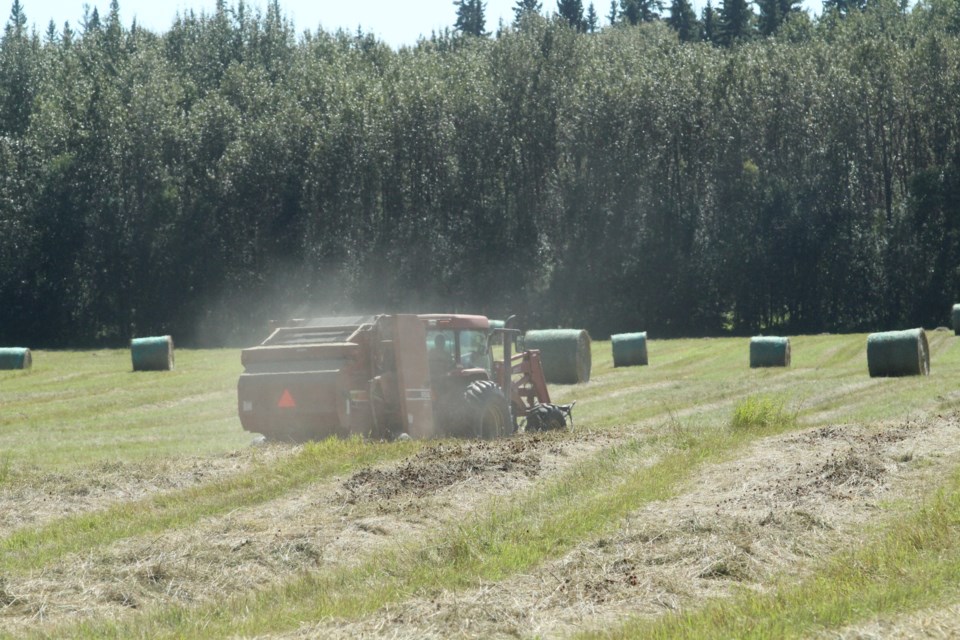For those who work in the regional agricultural industry, reaction to the weather in the Lakeland so far this year has been as varied as this year’s weather.
Keith Kernelsen, the agricultural fieldman for the County of St. Paul, says that while hot, dry conditions and wildfire smoke have created a significant challenge for local producers, so far, most have been able to sow their crops. He said that in the St. Paul region, overall, and thanks to rain at the right times, production is where it should be for this time of the year.
“Farmers in St. Paul have gotten along considerably better than those in other regions because we’ve had enough rain,” he said. “Furthermore, the smoke didn’t have as much as an adverse effect on the maturation of crops as was initially feared.”
While some areas have weathered the storms, that doesn’t mean all agricultural operations have been spared. Tthe drought–like conditions — which are also being attributed to a dry fall last year and a recent winter with relatively little snow — have affected the staging of various yields of common annual crops like canola, wheat and peas in areas around the region. Additionally, the dry weather has had a detrimental effect on cattle producers across the Lakeland.
“Due to the lack of water, some producers have decided to get out of business altogether,” he said. “In some quarters, the water levels are so low pastures are suffering. This, in turn, has forced a number of cattle producers to supplement their feed from hay crops.”
In neighbouring Lac La Biche County, the overall outlook is more blea. The region has experienced some of the driest weather in years, with hot, arid conditions delaying the grown stages of crops, says the municipality’s agriculture fieldman.
“Our producers are going through a struggle right now,” says Jacob Marfo. “Because of the shortage of rain, the ages of many crops are lower than in other parts of this region. They definitely are not where they should be for this time of the year.”
An alarming consequence of this rain deficit has meant that hay has increasingly become a scarce commodity.
“There is a concern among producers that there will not be enough bales of hay for this year,” he said. “A number of producers are keeping livestock in the fields longer due to this.”
While the extreme heat has caused other jurisdictions in the province to declare drought disasters, Lac La Biche County officials have not reached that point … yet.
“So far, the County has not had to have this discussion with the Minister of Agriculture,” Marfo said. “But if this area does not receive adequate rain soon, such measures may have to be considered.”
In the MD of Bonnyville, producers have seen a slightly better growing season in the fields.
Like their counterparts in St. Paul County, producers within the MD have experienced more precipitation enabling crops to grow at their normal rate.
“I must say, we’ve been lucky. Seeding went well, and we received some rain the rest of the province didn’t get,” says MD of Bonnyville Reeve Barry Kalinski. “The forage crops went to seed early and are being cut now. The downside is that we won’t see as many bales per acre as we’ve seen in past years.”
The reeve added quickly that while most of the agricultural update is positive, not all areas of the municipality can be included in the good-news report.
The western side of the municipality — bordering Lac La Biche County — he said, didn’t receive as much rain, meaning crops in that area have been delayed by as many as three weeks.
Ken Beniuk, who owns a mixed farming operation in the Craigend area of Lac La Biche County, explained while his crops have been growing well, the prolonged dry conditions are a great cause for concern.
“Right now, the water table is extremely low, meaning dugouts are low as well,” he stated. “One of the most pressing issues faced by cattle producers is a lack of water.”
There have been recent days of rainfall across the region, but many areas are still not receiving enough moisture to correct the low water table.
And without enough rainfall, even for producers who are faring well so far, the situation will go from bad to worse very fast.
“There really isn’t much that we can do, as we’re always at the mercy of the weather,” Beniuk said. “All anyone can do is hope that this stretch of hot weather will soon end.”



